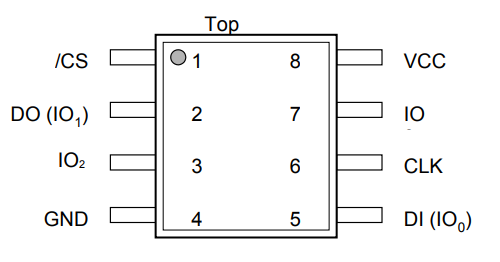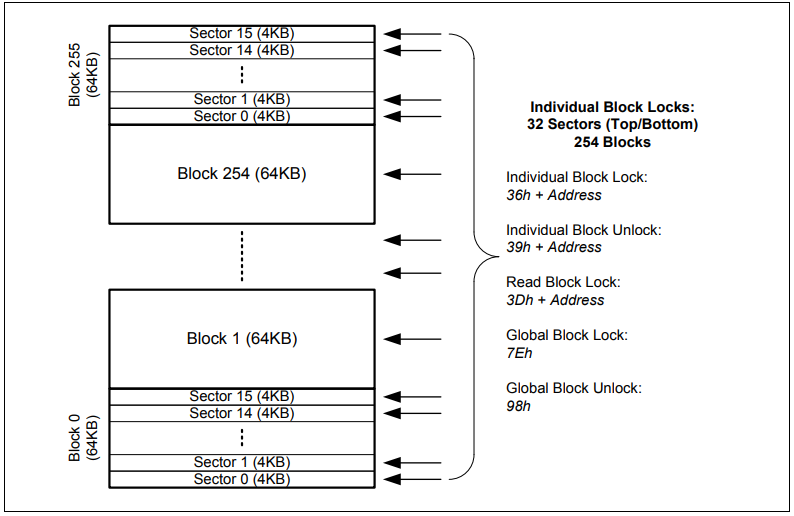Difference between revisions of "Serial Flash - W25Qxxx QuadSPI"
Jump to navigation
Jump to search
| (One intermediate revision by the same user not shown) | |||
| Line 1: | Line 1: | ||
| − | [[Category:STM32]][[Category:STM32 Hardware]][[Category:STM32 Development]]{{metadesc|QuadSPI Flash (W25Q128)}} | + | [[Category:STM32]][[Category:STM32 Hardware]][[Category:STM32 Development]]{{metadesc|QuadSPI Flash (W25Q128) information}} |
Serial flash IC's are quite common. They are typically named M25Qxxx where M is the manufacturer (W is for Winbond) and xxx is the size in bits. So the "W25Q128JV" is a Winbond flash with 128 bits = 16 MB. | Serial flash IC's are quite common. They are typically named M25Qxxx where M is the manufacturer (W is for Winbond) and xxx is the size in bits. So the "W25Q128JV" is a Winbond flash with 128 bits = 16 MB. | ||
| Line 144: | Line 144: | ||
* [https://github.com/amvasil/stm32-qspi-fat-usb Github project putting fatfs on qspi flash] | * [https://github.com/amvasil/stm32-qspi-fat-usb Github project putting fatfs on qspi flash] | ||
* [https://vivonomicon.com/2020/08/08/bare-metal-stm32-programming-part-12-using-quad-spi-flash-memory/ Bare metal QSPI Flash] | * [https://vivonomicon.com/2020/08/08/bare-metal-stm32-programming-part-12-using-quad-spi-flash-memory/ Bare metal QSPI Flash] | ||
| + | * [https://community.st.com/t5/stm32-mcus/how-to-add-your-spi-flash-into-the-stm32cubeprogrammer-s/ta-p/49392 How to add your SPI flash memory into the STM32CubeProgrammer’s external loader?] | ||
Latest revision as of 02:43, 31 October 2024
Serial flash IC's are quite common. They are typically named M25Qxxx where M is the manufacturer (W is for Winbond) and xxx is the size in bits. So the "W25Q128JV" is a Winbond flash with 128 bits = 16 MB.
Pinout
The serial flash IC's typically have a pinout like:
They can operate in either plain SPI mode (using DI and DO as MOSI/MISO) or so-called Quad SPI (4 data lines) using IO0-IO3.
Memory Organisation
Internally the flash is organised like this:
Bytes in the flash can be read/write individually, but before "writing" the address of the write needs to be "erased" (set to 0xff) and erase can only be done by "sector" (4kB in the above example -
STM32L4 training - Hands-on QSPI
Source Example
Working:
QSPI_CommandTypeDef sCommand;
static uint8_t id[17] = { 0 };
static uint8_t tx_buf[0x10] = "Ext Flash";
static uint8_t rx_buf[0x10] = { 0 };
sCommand.DdrMode = QSPI_DDR_MODE_DISABLE;
sCommand.DdrHoldHalfCycle = QSPI_DDR_HHC_ANALOG_DELAY;
sCommand.SIOOMode = QSPI_SIOO_INST_EVERY_CMD;
/***** Read ID operation*****/
sCommand.Instruction = 0x9F; //READ ID command code
sCommand.InstructionMode = QSPI_INSTRUCTION_1_LINE; //Command line width
sCommand.AddressMode = QSPI_ADDRESS_NONE; //Address line width. No address phase
sCommand.DataMode = QSPI_DATA_1_LINE; //Data line width
sCommand.NbData = 17; //Read the data length. ID length is 17 bytes
sCommand.AlternateByteMode = QSPI_ALTERNATE_BYTES_NONE; //No multiplexing byte stage
sCommand.DummyCycles = 0; //No Dummy phase
//Configuration command (when there is data stage, the command will be sent in the subsequent sending/receiving API call)
if (HAL_QSPI_Command(&hqspi, &sCommand, 5000) != HAL_OK) {
Error_Handler();
}
//Execute QSPI reception
if (HAL_QSPI_Receive(&hqspi, id, 5000) != HAL_OK) {
Error_Handler();
}
/***** Write enable operation (need to make the external memory in the write enable state before block erasing) *****/
sCommand.Instruction = 0x06; //Write enable command code
sCommand.InstructionMode = QSPI_INSTRUCTION_1_LINE; //Command line width
sCommand.AddressMode = QSPI_ADDRESS_NONE; //Address line width. No address phase
sCommand.DataMode = QSPI_DATA_NONE; //Data line width. No data stage
sCommand.AlternateByteMode = QSPI_ALTERNATE_BYTES_NONE; //No multiplexing byte stage
sCommand.DummyCycles = 0; //No Dummy phase
//Configure sending command
if (HAL_QSPI_Command(&hqspi, &sCommand, 5000) != HAL_OK) {
Error_Handler();
}
/***** Block erase operation*****/
sCommand.Instruction = 0xD8; //Sector erase command code
sCommand.InstructionMode = QSPI_INSTRUCTION_1_LINE; //Command line width
sCommand.AddressMode = QSPI_ADDRESS_1_LINE; //Address line width. No address phase
sCommand.AddressSize = QSPI_ADDRESS_24_BITS; //Address length
sCommand.Address = 0; //Any address in the sector to be erased.
sCommand.DataMode = QSPI_DATA_NONE; //Data line width. No data stage
sCommand.AlternateByteMode = QSPI_ALTERNATE_BYTES_NONE; //No multiplexing byte stage
sCommand.DummyCycles = 0; //No Dummy phase
//Configure sending command
if (HAL_QSPI_Command(&hqspi, &sCommand, 5000) != HAL_OK) {
Error_Handler();
}
HAL_Delay(3000); //Delay 3s. The unit is SysTick timer interrupt period
/***** Write enable operation (need to make the external memory in the write enable state before block erasing) *****/
sCommand.Instruction = 0x06; //Write enable command code
sCommand.InstructionMode = QSPI_INSTRUCTION_1_LINE; //Command line width
sCommand.AddressMode = QSPI_ADDRESS_NONE; //Address line width. No address phase
sCommand.DataMode = QSPI_DATA_NONE; //Data line width. No data stage
sCommand.AlternateByteMode = QSPI_ALTERNATE_BYTES_NONE; //No multiplexing byte stage
sCommand.DummyCycles = 0; //No Dummy phase
//Configure sending command
if (HAL_QSPI_Command(&hqspi, &sCommand, 5000) != HAL_OK) {
Error_Handler();
}
/***** Four-wire fast write operation*****/
sCommand.Instruction = 0x32; //Quick write command code with four lines
sCommand.InstructionMode = QSPI_INSTRUCTION_1_LINE; //Command line width
sCommand.AddressMode = QSPI_ADDRESS_1_LINE; //Address line width
sCommand.AddressSize = QSPI_ADDRESS_24_BITS; //Address length
sCommand.Address = 0; //Write the starting address
sCommand.DataMode = QSPI_DATA_4_LINES; //Data line width
sCommand.NbData = 10; //write data length
sCommand.AlternateByteMode = QSPI_ALTERNATE_BYTES_NONE; //No multiplexing byte stage
sCommand.DummyCycles = 0; //No Dummy phase
//Configuration command (when there is data stage, the command will be sent in the subsequent sending/receiving API call)
if (HAL_QSPI_Command(&hqspi, &sCommand, 5000) != HAL_OK) {
Error_Handler();
}
//Execute QSPI reception
if (HAL_QSPI_Transmit(&hqspi, tx_buf, 5000) != HAL_OK) {
Error_Handler();
}
HAL_Delay(5); //Delay 5ms. The unit is SysTick timer interrupt period
/***** Four-wire fast read operation*****/
sCommand.Instruction = 0x6B; //Quick read command code with four lines
sCommand.InstructionMode = QSPI_INSTRUCTION_1_LINE; //Command line width
sCommand.AddressMode = QSPI_ADDRESS_1_LINE; //Address line width
sCommand.AddressSize = QSPI_ADDRESS_24_BITS; //Address length
sCommand.Address = 0; //Start address
sCommand.DataMode = QSPI_DATA_4_LINES; //Data line width
sCommand.NbData = 10; //Read data length
sCommand.AlternateByteMode = QSPI_ALTERNATE_BYTES_NONE; //No multiplexing byte stage
sCommand.DummyCycles = 8; //Dummy phase. N25Q128A13EF840F
//Configuration command (when there is data stage, the command will be sent in the subsequent sending/receiving API call)
if (HAL_QSPI_Command(&hqspi, &sCommand, 5000) != HAL_OK) {
Error_Handler();
}
//Execute QSPI reception
if (HAL_QSPI_Receive(&hqspi, rx_buf, 5000) != HAL_OK) {
Error_Handler();
}
Miscellaneous Links
- W25Q128JV Datasheet
- GD25Q128E Datasheet
- GD25LQ64C Datasheet
- LittleFS on SPI Flash (W28Q64)
- How to use W25Q16 FLASH memory in STM32F4 with HAL Driver?
- Quad-SPI interface on STM32 microcontrollers and microprocessors
- Github project putting fatfs on qspi flash
- Bare metal QSPI Flash
- How to add your SPI flash memory into the STM32CubeProgrammer’s external loader?

